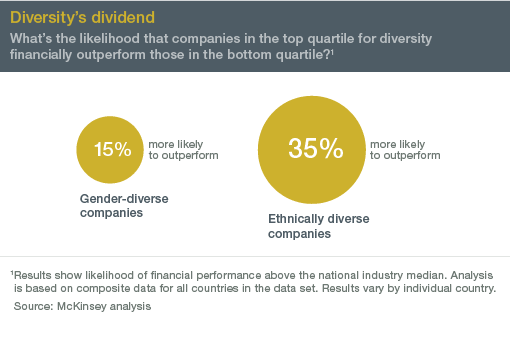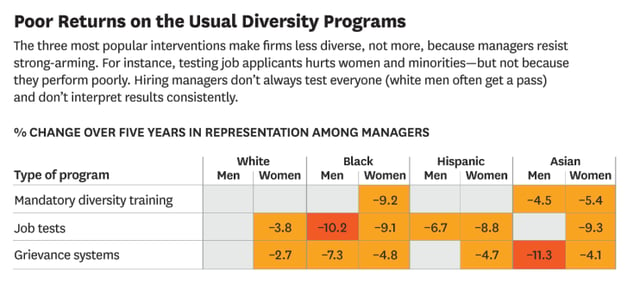As the recent Google memo fiasco showed, diversity and inclusion remain a challenge even for the world’s most successful companies.
Diversity, inclusion, and integrity aren’t just buzzwords; they are critical instruments for building a better, more sustainable business. They are also powerful recruiting tools - talented people want to work in a company that values them and cherishes their differences.
In a people-centric business, this can be a powerful competitive advantage.
So how exactly do you build a culture of diversity in your agency? How do you practice inclusion across your organization?
In this article, I’ll share some approaches and strategies for building a better company culture.
The Value of Diversity
The agency business is essentially a people business. Your competitive advantage isn’t your supply chain or your technology; it’s the kind of people you can attract and retain.
It stands to reason that in a people-centric business, the more diverse people you can attract, the higher your impact.
This is borne true by research. A McKinsey report titled Why Diversity Matters found that companies in the top quartile for diversity are 35% more likely to outperform those in the bottom quartile.

Another study by Catalyst found that companies with the most women board of directors outperformed those with the least by 26% on Return on Invested Capital (ROIC).
Beyond financial results, diversity has a decided impact on innovation - provided you make your people feel included regardless of their backgrounds. A Deloitte study found that:
“When employees think their organization is committed to, and supportive of diversity and they feel included, employees report better business performance in terms of ability to innovate, (83% uplift), responsiveness to changing customer needs (31% uplift) and team collaboration (42% uplift).”
Qualitatively speaking, a more diverse team is better at fusing ideas from multiple perspectives - the root of all creativity. A paper published in the Personality and Social Psychology Bulletin concluded that:
“Multicultural learning experience: (a) facilitates idea flexibility (e.g., the ability to solve problems in multiple ways), (b) increases awareness of underlying connections and associations, and (c) helps overcome functional fixedness... functional learning in a multicultural context is particularly important for facilitating creativity.”
Ergo, diversity, and inclusion make your business better at innovative thinking, creativity, and collaboration - critical skills for agencies.
A wide-ranging study of 1,800 professionals that appeared in Harvard Business Review had similar conclusions. The study found that:
“Employees of firms with diversity are 45% likelier to report a growth in market share over the previous year and 70% likelier to report that the firm captured a new market.”
There’s yet another benefit to having a diverse team: you become better at dealing with a wider range of clients. As the above-referenced Harvard study found:
“We’ve found that when at least one member of a team has traits in common with the end user, the entire team better understands that user. A team with a member who shares a client’s ethnicity is 152% likelier than another team to understand that client.”
At a time when agencies are branching out of their home markets to attract global clients, this is nothing short of a superpower.
Happier workers, more innovative teams, and better financial performance - these are just some of the perks of diversity. The literature on this subject - qualitative as well as quantitative - is enormous. I urge you to read some of it and learn about the benefits yourself.
In the next section, I’ll share some strategies for creating and promoting a culture of diversity and inclusion in your agency.
Strategies for Creating a More Diverse and Inclusive Workplace
Diversity is a big undertaking. Embracing it doesn’t just mean embracing a few tactics; it means changing the very way your business works.
Creating a culture of diversity requires a broad strategic approach and a narrow tactical focus. The latter is informed by the former.
Let’s look at some strategies for embracing diversity in your agency.
Understand that there are no quick fixes
According to the Equal Employment Commission’s 2014 report, the number of black men in managerial roles in businesses with >100 employees increased from just 3% to 3.3% from 1985. The data is similarly disappointing for a large number of industries. The number of white female managers at commercial banks dropped from 39% to 35% from 2003 to 2014.
Meager returns given the decade's long-focus on diversity programs.
One reason why so many diversity programs fail is that they misunderstand the very nature of diversity. Diversity is not a quick-fix solution. It isn’t a weekend-long training program that can be done once and forgotten the next week.
Rather, diversity is a long-term endeavor. It bears results over years, not months.
As Dr. Anne Phibbs, founder of Strategic Diversity Initiatives writes:
“We’re talking about changing hearts and minds and really deeply held beliefs that have impacted us.”
The programs that have proven to actually improve diversity - targeted college recruitment, mentoring programs, self-managed teams, etc. - are all long-term efforts. They work at the root cause of diversity (talent supply and management).
Understanding that there are no quick fixes to the diversity problem should be the first step in implementing diversity.
Beware of diversity training
Echoing the above sentiment, a common strategy for businesses to implement diversity is to offer mandatory diversity training.
Yet, the data suggests that such programs offer little to no long-term benefits. A study of the % change in representation over 5 years among managers showed that diversity training had a net negative effect:

What gives?
Research shows that when any training that focuses on the negative consequences of biased behavior (“discriminate and you’ll be fired!”) actually reinforces biased behavior. Another study found that when participants in diversity training programs are forced to agree to an anti-bias viewpoint, they actually feel more biased. When they’re left free to make their own choice, bias goes down as well.
Thus, while diversity training is prevalent, it isn’t always the best solution.
Make diversity a core part of your leadership
If there’s one thing most experts agree with, it’s this: for diversity programs to work, leaders need to show commitment to diversity.
Writing in Management Today, Stanford GSB professor Brian Lowery says:
“Failures of diversity are fundamentally failures of leadership - specifically, a failure to understand both what really constitutes good leadership and how leadership sets the tone for how effectively challenges around diversity are handled within an organisation.”
An HBR survey of 24 CEOs who’ve had success with diversity initiatives shows that successful diversity programs have leadership buy-in. As HBR quotes,
“The CEOs we spoke with did not see diversity as a once-and-done initiative, nor did they hand off the responsibility for it to others. Rather, each of the 24, in his or her own way, approached inclusivity as a personal mission.”
For most of these CEOs, diversity was not only a business imperative but a moral one as well. They led diversity initiatives because many of them were from diverse backgrounds themselves and thus, were familiar with the effects of discrimination.
As Ajay Banga, CEO of MasterCard says:
“My passion for diversity comes from the fact that I myself am diverse. There have been a hundred times when I have felt different from other people in the room or in the business”.
This is to say, the more diverse your leadership is, the more your business will be comfortable with diversity. If your senior executives are all from the same background, it is possible that they might unintentionally overlook the importance of diversity.
Therefore, when initiating diversity programs, start from the top. Get leaders to fully commit to diversity. Only then will the rest of the organization follow.
Diversity without inclusion is useless
Diversity, by itself, simply means equal representation. But if equal representation isn’t followed by equal inclusion, you won’t bear the fruits of diversity.
As Hugo Balta writes, “Diversity without inclusion is only skin deep”.
Inclusion is essentially active involvement. It means getting people to engage deeply with problems and to listen to their concerns. It also means promoting authenticity - getting people to express, not suppress their unique cultures.
According to the Center for Talent Innovation, there are six behaviors that unlock innovation:
- Ensuring that everyone is heard.
- Making it safe to propose novel ideas.
- Giving team members decision-making authority.
- Sharing credit for success.
- Giving actionable feedback.
- Implementing feedback from the team.
When team leaders have at least three of the above behavioral traits, 87% of diverse team members say that they feel included in their team. 87% also say that they feel free to express their views and opinions.
Don’t just focus on diversity; focus on inclusion as well.
Diversity should not be in isolation
A common mistake organizations make when implementing diversity is to set it apart from the rest of the business. They might have a diversity office and even a VP of diversity, but this office remains in isolation.
This can create a sense of complacency and myopia. Leaders might disengage with diversity issues because they believe that the problem is being handled by the diversity office.
This is to say, just as the product team doesn’t bother with accounting issues (that’s the domain of the finance department), a diversity office might cause the rest of the organization to similarly de-emphasize diversity issues.
The antidote to this problem is to make the diversity office a core part of the organization.
As Steven Schulman writes in the Diversity Journal:
“The diversity office must be viewed as a partner, rather than the sole driver of a company’s culture of acceptance and inclusion. It should be the foundation upon which an inclusive culture is built, by the support and strength of senior management, human resources, and employees.”
That is, diversity should be ingrained in your business’ DNA, and not just treated as yet another corporate department.
6 Tactics for Promoting Diversity, Inclusion, and Integrity
In the previous section, we saw some broad strategic approaches to promote diversity and inclusiveness.
However, sound strategies need effective tactics to bear results. In this section, I’ll share some actionable tactics you can implement to create a culture that values diversity, inclusion and integrity.
1. Institute mentoring programs
When Frank Dobbin, professor of sociology at Harvard University, was asked by McKinsey about “any [diversity] programs that you wanted for the largest companies in America”, this is what he had to say:
“One of the most effective solutions for promoting women and minorities into management is formal mentoring programs. The key is that they connect people who didn’t know each other before, who are from different departments and a couple of levels in the hierarchy apart.”
Formal mentoring programs are particularly effective since in most organizations, people up the chain of command tend to be white men. A mentorship program that connects them with younger colleagues (who tend to be from a wider cultural/social swathe) is, by default, “diverse”.
2. Embrace the “Rooney Rule”
In 2003, the NFL adopted a rule named after Dan Rooney, former owner of the Pittsburgh Steelers. As per this “Rooney Rule”, all NFL teams are required to interview minority candidates for head coaching and senior operational roles.
The rule has been widely successful - the percentage of African-American coaches in the NFL jumped from 6% to 22% since it was put in place.
Consider using this rule in your vacancies, especially for senior managerial roles. Companies like Facebook and Pinterest are already using it with strong results.
3. Observe diverse traditions, celebrations, and holidays
“Sharing” is a core tenet of inclusion. An easy way to promote this sentiment of sharing is to celebrate traditions and holidays from different cultures.
If you have Hindus in your team, organize a color run for “Holi” and light up a few lamps for “Diwali”. For your Muslim team members, celebrate Eid. Have some celebrations when the Chinese New Year rolls around.
The idea is to show that you are: a) aware of different cultural traditions, and b) you want everyone to celebrate these traditions together. This will make minority team members feel more at home.
Plus, celebrating different traditions can be a lot of fun for everyone involved.
4. Create Employee Resource Groups (ERG)
Employee Resource Groups (ERGs) are voluntary, employee-led social groups that give minorities a place to network and grow. These are becoming increasingly common in larger organizations as catalysts for promoting diversity. 90% of Fortune 500 companies have ERGs.
For example, these are some of Princeton University’s ERGs:

ERGs give minorities a place to foster their cultural heritage. But they have another benefit: they can act as in-house think tanks. Giving minorities a voice also gives them an opportunity to come together and promote diverse thinking.
5. Set up a diversity committee
Remember the Frank Dobbin interview I mentioned earlier?
In the same interview, Prof. Alexandra Kalev of Tel-Aviv University had this to say about her choice of diversity programs:
“Diversity committees. Having a VP for diversity and diversity committees throughout the organization, that report to the CEO every six months—I think this is the mother of all programs.”
A growing number of forward-looking companies are embracing this tactic. Google hired a VP of diversity early in August following the Google Memo debacle. Apple hired its first VP of diversity earlier in May this year. And Twitter hired one in June.
Any forward-thinking agency should definitely consider this option.
6. Match employer-brand with consumer-brand
80% of job seekers research employers before applying for a job.
This begs the question: how do potential employees see you as an employer? Do they see you as yet another agency or a place that will value their talent and diversity?
If you want to attract the best possible talent, you have to brand yourself as an attractive employer. The care and attention that goes into your client-facing brand should also go into your employer brand.
Any and all recruitment-focused material you put out - job ads, ‘now hiring’ pages, etc. - should reflect your commitment to innovation, diversity and any other values you espouse in your client brand.
By positioning yourself as a diversity-friendly employer, you will automatically attract more diverse job applicants.
Conclusion
Diversity, integrity, and inclusion are some of the great HR challenges of our time. They're also some of the biggest opportunities - the successful agencies of the future will invariably be the most diverse ones.
Diversity has a profound impact on innovation and creativity. It also leads to happier workplaces and better financial performance.
How you promote diversity is subjective, but a strategic approach that focuses on making diversity a core part of leadership and ingraining it into your corporate DNA helps.
At the same time, you need to institute a number of tactics to actively promote diversity. Even simple things such as celebrating different holidays, setting up a diversity committee, and creating employee resource groups (ERGs) can help.
Here’s what you should take away from this post:
- Diversity improves innovation, creativity, and financial results.
- There are no quick fixes to diversity issues; you need a long-term commitment to see results.
- Diversity should be a core part of your organization, not yet another isolated department.
- Instituting mentorship programs and setting up an office of diversity can have a profound impact on diversity.

